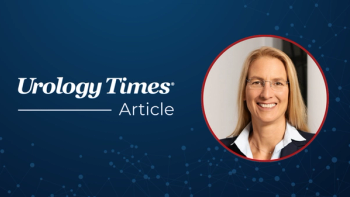
Urology Times Urologists in Cancer Care
- UCC September 2021
- Volume 10
- Issue 03
Recognizing hereditary syndromes in renal cell carcinoma
Patients may require specific diagnostic, surveillance, and therapeutic management.
Hereditary renal cell carcinoma (RCC) may account for up to 8% of RCC, and extrarenal manifestations may present in early childhood. Establishing screening guidelines for hereditary RCC may help identify individuals at increased risk of developing extrarenal manifestations, which can vary. With renal and extrarenal manifestations, a referral to a multidisciplinary team ensures a long-term treatment plan is in place to monitor for complications. Furthermore, the early onset of cancers in hereditary syndromes emphasizes the need for regular surveillance to focus on primary preventive strategies to reduce morbidity and increase life expectancy in affected individuals.
Hereditary RCC syndromes have led to the discovery of key mechanisms underlying sporadic RCC and have become a foundation for the development of targeted therapy. As an example, von Hippel-Lindau (VHL) disease is an autosomal dominant disorder caused by germline mutations in the VHL gene. The most common sporadic RCC histology is clear cell RCC (ccRCC), which is also associated with VHL mutations. The VHL gene product, the protein VHL, acts as an oxygen sensor that regulates degradation of the hypoxia-inducible factors (HIFs). The HIF transcription factors bind hypoxia-related elements to activate target genes, such as vascular endothelial growth factor (VEGF), involved in how cells sense and adapt to low oxygen levels. As a result of these discoveries in VHL pathogenesis, the 2019 Nobel Prize (William Kaelin, MD; Sir Peter Ratcliffe, MD; and Gregg Semenza, MD, PhD) was awarded for elucidating how cells regulate blood vessel growth. These discoveries served as the foundation for antiangiogenic therapies (axitinib [Inlyta], bevacizumab [Avastin], cabozantinib [Cabometyx], lenvatinib [Lenvima], pazopanib [Votrient], sorafenib [Nexavar], sunitinib [Sutent], and tivozanib [Fotivda]) used in the treatment of metastatic RCC. Given the autosomal dominant nature of inheritance in VHL disease, affected individuals have a 50% chance of having an affected child. Affected individuals may have a de novo germline VHL mutation or inherit a nonfunctional VHL allele from one of their parents. A subsequent secondary inactivation of the other allele is associated with the development of both renal (ccRCC) and extrarenal tumors (endolymphatic sac tumors, pancreatic neuroendocrine tumors, pheochromocytomas, and retinal/central nervous system hemangioblastomas). Even if a tumor is surgically removed, tumors can recur or new ones can develop over an affected individual’s lifetime because of germline mutations. Consistent with a hereditary RCC syndrome, the average age of ccRCC onset is 35 years in VHL disease, which is almost 30 years earlier than the age of onset in sporadic ccRCC.
Surveillance guidelines focus on physical examinations, blood tests, and imaging tests at specific time intervals to monitor existing tumors as well as evaluate for new tumors. Following established surveillance guidelines (
The median age of individuals with sporadic RCC is 64 years in an analysis of the Surveillance, Epidemiology, and End Results (SEER)-17 registry program, which was considerably older than the median age of 37 years in an independent cohort of National Cancer Institute Urologic Oncology Branch individuals affected by hereditary RCC.1 Individuals with hereditary RCC syndromes had median ages of onset ranging from 35 to 50 years. Because the median age of presentation for hereditary RCC is 27 years younger than for RCC observed in the general population, the NCI study suggested that individuals affected by RCC who are 46 or younger be referred for genetic counseling even in the absence of overt extrarenal clinical manifestations.
Patients with hereditary RCC syndromes require specific diagnostic, surveillance, and therapeutic management. Many of the clinical manifestations of hereditary RCC syndromes can be challenging for a clinician to recall. However, an early age of cancer diagnosis may be an initial clue to identify patients who may benefit from further genetic testing and referral to a multidisciplinary treatment team. In the setting of a hereditary RCC syndrome, an adherence to established surveillance strategies, an appropriate management of the renal and extrarenal disease manifestations, and attention to at-risk family members will lead to improvement in clinical outcome. The observed early onset of hereditary RCC indicates that primary preventive strategies are more likely to increase life expectancy in affected individuals than administering targeted therapies in the metastatic setting. Individuals 46 or younger affected by RCC should be considered for genetic counseling and germline mutational testing, even in the absence of secondary clinical manifestations.
Dr. Ho is an associate professor of medicine in the Division of Hematology/Oncology, Department of Internal Medicine at Mayo Clinic, Phoenix, Arizona.
Reference
1. Shuch B, Vourganti S, Ricketts CJ, et al. Defining early-onset kidney cancer: implications for germline and somatic mutation testing and clinical management. J Clin Oncol. 2014;32(5):431-437. doi:10.1200/JCO.2013.50.8192
Articles in this issue
over 4 years ago
Strategies to enable same-day robotic urologic surgeryover 4 years ago
Genetic counselor discusses her role in patient careover 4 years ago
The challenges of prostate cancer managementNewsletter
Stay current with the latest urology news and practice-changing insights — sign up now for the essential updates every urologist needs.


















